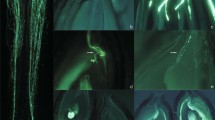Summary
In the glasshouse the five spring wheat varieties Gaby, Jufy I, Opal, Orca and Peko were investigated for differences in number of anthers extruding during florescence. A maximum of 4 ears per plant was maintained. The mean of the absolute number of extruding anthers per ear varied from 105 (Peko) to 170 (Gaby). Also, significant differences were established in the absolute number of extruding anthers divided by the number of seeds set in each ear; this value ranged on an average of 2.27 (Opal) to 3.58 (Gaby). It is remarkable that a variety-ear number interaction manifests itself for both mentioned data: as far as Jufy is concerned the first developing ear produces least, whereas in Orca and Peko it produces most. No significant differences in this respect occur between the first 4 ears of a plant of the varieties Gaby and Opal. A simple relationship between number of extruding anthers and pollen donor capacity on the field could not be demonstrated.
The flowering pattern and duration of ears and plants of these five varieties varies considerably. The mean flowering duration of each individual ear runs from 4.92 (Opal) to 6.35 days (Jufy). In addition to this a difference in flowering pattern is found, i.e. a certain number of days after the beginning of flowering Jufy appears to have turned out the smallest percentage of its total production of extruding anthers, while Opal had produced the greatest (Fig. 2). As regards this phenomenon, the first ear of a plant generally appears to lag significantly behind the second and third. Trying to explain these phenomena, on the one hand it was taken into account that in the case of varieties which extrude many anthers, florets of the third rank and higher will be more involved; these are not scored until later in the flowering period of the ear, which implies a proportionally smaller share for the first flowering days. On the other hand a slower or faster physiological flowering process is supposed.
There appears to be a much bigger difference in outset of flowering between the first and the second ear of a plant than between the second and the third. For Jufy the first mentioned difference is bigger than for the other varieties. The mean flowering duration per plant of these five varieties varies (for 3 ears per plant) from 8.6 (Opal) to 10.7 days (Jufy).
Similar content being viewed by others
References
Barnett, R. D., 1970. Factors influencing pollen dispersal and cross-pollination of soft red winter wheat. Ph. D. Thesis, Purdue University, 87 pp.
Milohnic J. & M.Jost, 1970. Pollen production and auther extrusion of wheat (Triticum aestivum L. em Thell.). Acta Agron. Hung. 19 (1–2): 17–23.
Vries A. Ph.de, 1971. Flowering biology of wheat, particularly in view of hybrid seed production —a review. Euphytica 20: 152–170.
Vries A. Ph.de, 1972. Some aspects of cross-pollination in wheat (Triticum aestivum L.). 1. Pollen concentration on the field as influenced by variety, diurnal pattern, weather conditions and level as compared to the height of the pollen donor. Euphytica 21: 185–203.
Author information
Authors and Affiliations
Rights and permissions
About this article
Cite this article
De Vries, A.P. Some aspects of cross-pollination in wheat (Triticum aestivum L.) 2. Anther extrusion and ear and plant flowering pattern and duration. Euphytica 22, 445–456 (1973). https://doi.org/10.1007/BF00036640
Received:
Issue Date:
DOI: https://doi.org/10.1007/BF00036640




